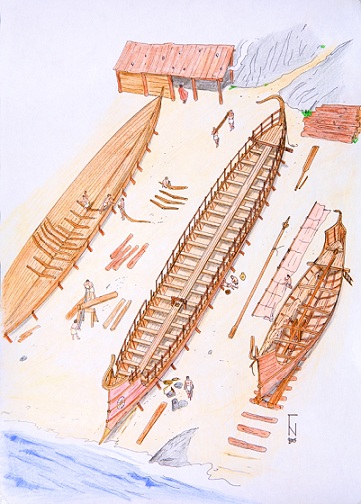The Polyremes of the Geometric period
From the Geometric, and the archaic periods some superb examples of vase painting with representations of beautiful sleek ships have been preserved. This is the period of the development of the longship which is pictures with a mpaddingultitude of oars and sometime with more than a bank of oarsmen. The polyeries or multiremes make then their appearance with a novelty, the ram, a deadly weapon that is present on every ship intended to be used for warfare.
These oared warships that are first depicted in the 8th c. B.C. will continue to prevail in the Mediterranean for another twenty three centuries. The battle of Lepanto, fought in 1571, between the United Christian fleet and the Ottoman fleet — reinforced by Tunisian vessels — at the entrance of the Corinthian Gulf, marks the end of the multireme hegemony on the seas. For another two hundred and fifty years (until the use of steam) it the sailing ship tactics that will prevail in naval warfare.
Most of the early geometric naval representations are painted on Craters, large clay vases, the majority found on Greece Mainland; Boeotia and Attica in particular. The nicest and largest early geometric ship depictions are dated to the 8th century B.C. A fine example with of Boeotian provenance is a crater from Thebes, dated to 735 -710 B.C. now in the British Museum. It shows a large ship with three banks of oarsmen: an early example of a trireme (triere).
It should be reminded that this was the time when the Greek colonization was at its peak (8th c. to 6thc. B.C.) and trade sea-routes the Mediterranean and the Black Sea. Greek ships regularly sailed from the Greek ports of Greece mainland, the islands, the Asia Minor shores, to the Black Sea, Magna Graecia, to the Greek Colonies of Southern France and continued eastwards to the Pillars of Hercules and well beyond. They also reached the Seas of the North, the Islands of the tin (British Isles). These ships did not only carry merchandise in their holds and passengers on their decks, but also transported the culture and the ideals of the Greek civilization.
From the end of the 6th c. to the 4th c. B.C. we have masterpieces of ship iconography; on vase painting, low relief, statuary, that have survived, giving precious details on the construction of the ship, its hull, steering mechanism, mast, sail and rigging, as well as of their decoration. It should be remembered that the ancient ship was then the largest, most intricate and complex technological achievement.
One of these masterpieces of vase painting, dated to 570 B.C., is the ship representation on the so-called “Vase François”, now in the Archaeological Museum of Florence. Theseus is represented landing on the island of Delos; he disembarks from a sleek ship while some 17 of his companions remain on board. The names of the painter, as well as the potter of this great work of art are known; the inscription read: Kleitias and Egotimou. Another, famous vase painting made in 550-530 is the red glazed kylix of Exikias kept in the Munich Archaeological Museum. It is known as the “Dionysus kylix”. Dionysus, a happy god, the god of wine, sails on a beautiful ship; the ram is protruding, it is a warship. The sail is white and square, while the two lateral steering oars are realistically represented. The vine full of heavy grapes is interlacing above the mast and ship’s antenna. Dolphins are playing, jumping out of the Aegean waters.
Another preferred scene, often depicted during that period on different type of vases, shows Ulysses tied by his companions to the mast of his ship”, because of his insistence to experience the melodious, but bewitching song, of the sirens which surround the vessel. We can learn by studying the numerous details of “Ulysses ship” and gain information on its structure and decor. The position of the oars, the steering mechanism with the blades of the quarter-oars apparent, the “ophthalmoi”, painted as symbols on the bow, the reefed sail, the brailing lines, the standing and running rigging, the impressive ram, the bulwark and other interesting features are well depicted in a realistic manner.

